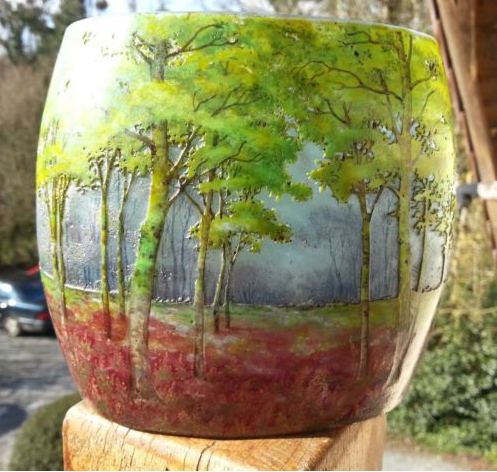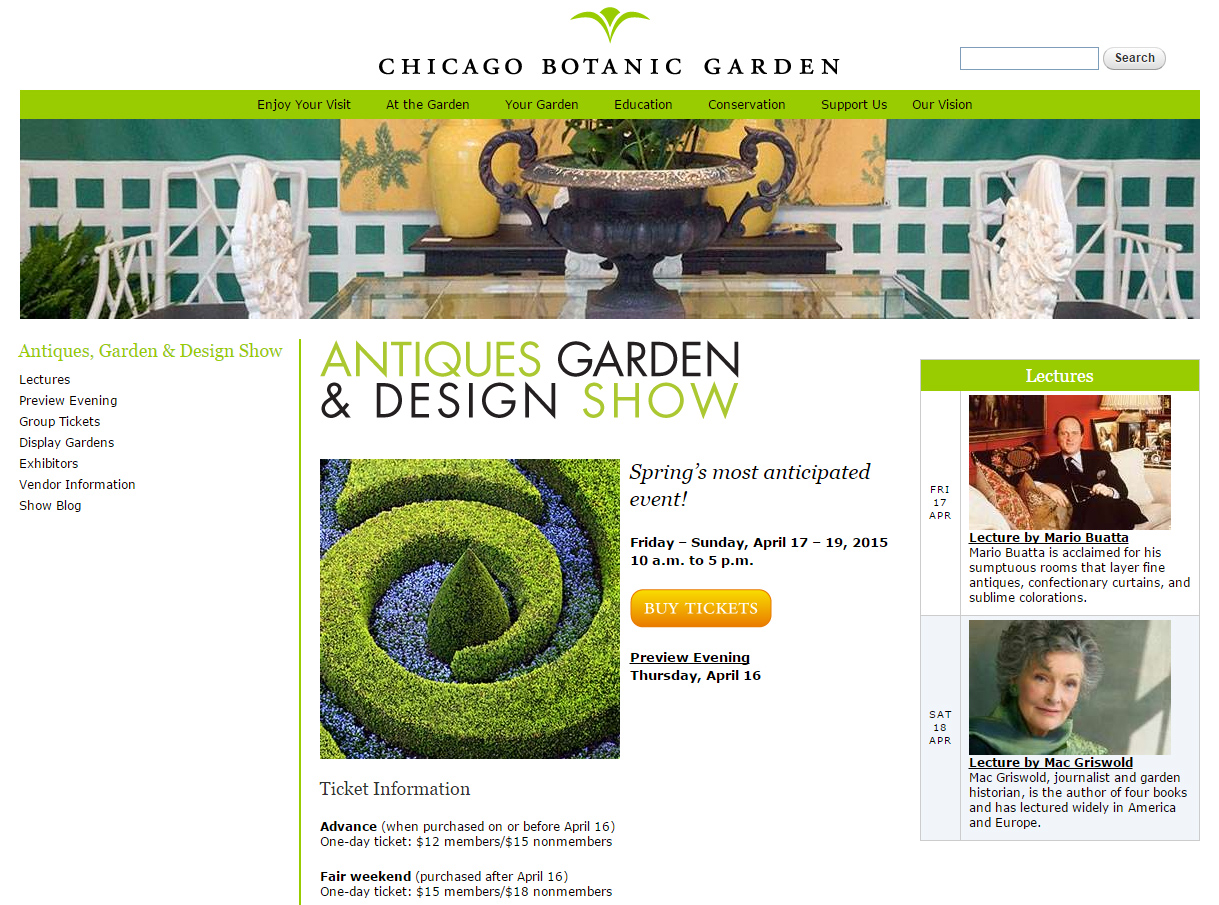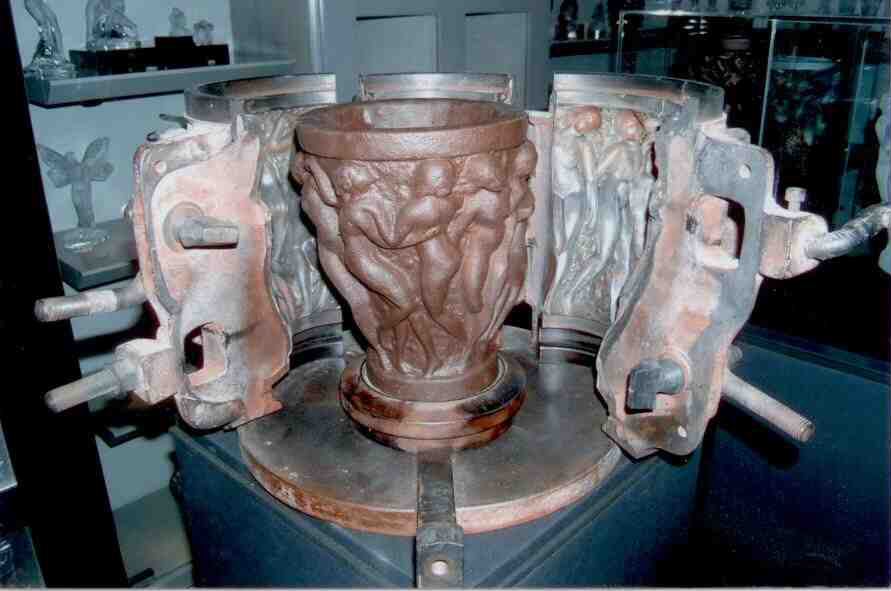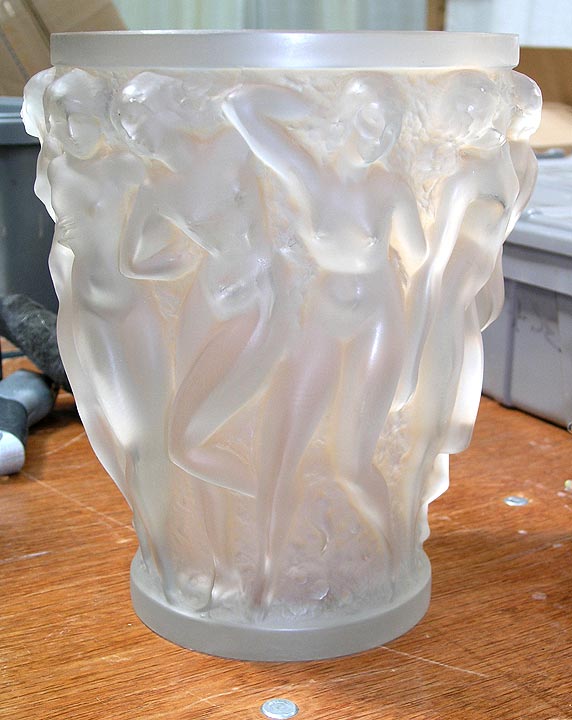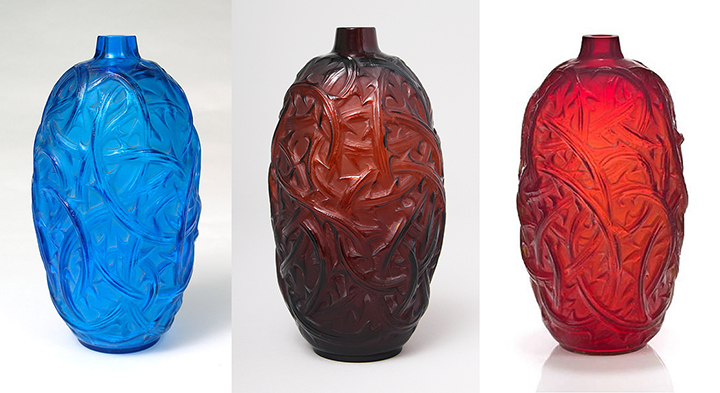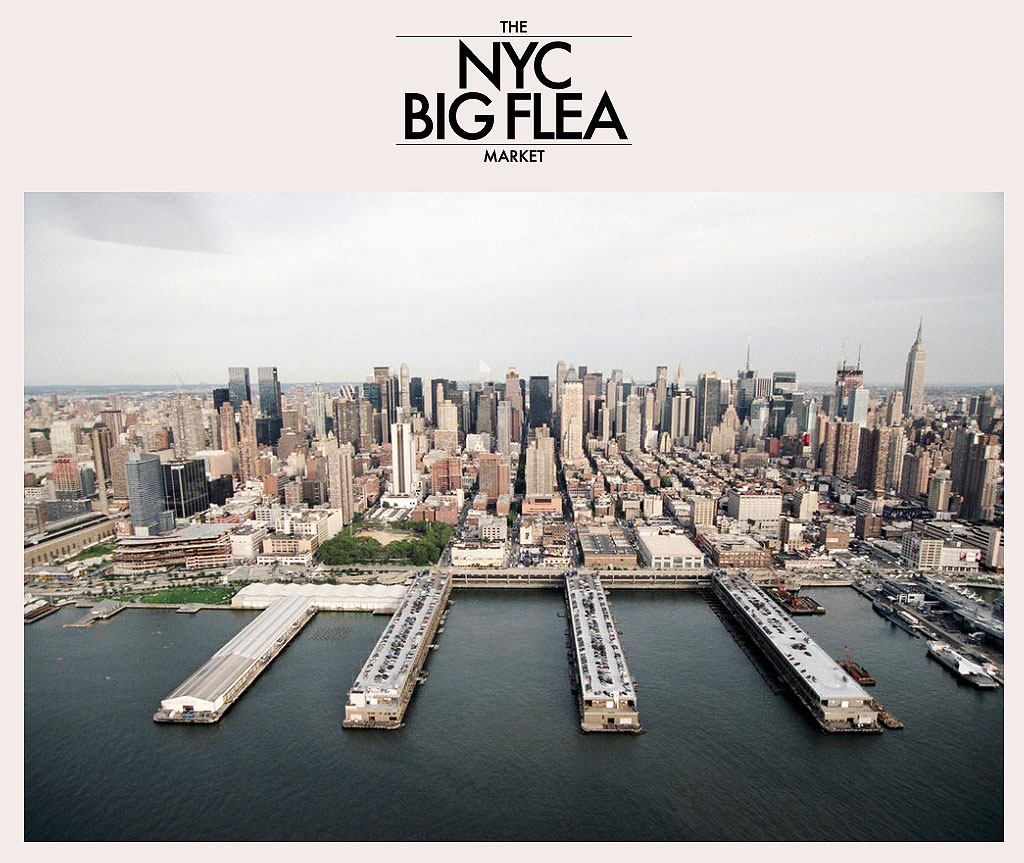My goal is to publish new posts twice a week — Mondays and Thursdays. However, if you don’t see a new post on Thursday, it’s because I was too busy, so please look for a new one the following Monday.
Today’s guest post is by David Rago, republished with permission from Bidsquare. David Rago is Partner and Co-Director of the 20th/21st C. Design Department of the Rago Arts & Auction Center in Lambertville, New Jersey.
Unless you’re selling gold ingots or diamonds, most fine objects don’t have intrinsic monetary value. So why would anyone pay tens of thousands of dollars for a Tiffany vase? To truly understand value, you have to understand the mindset of a collector.
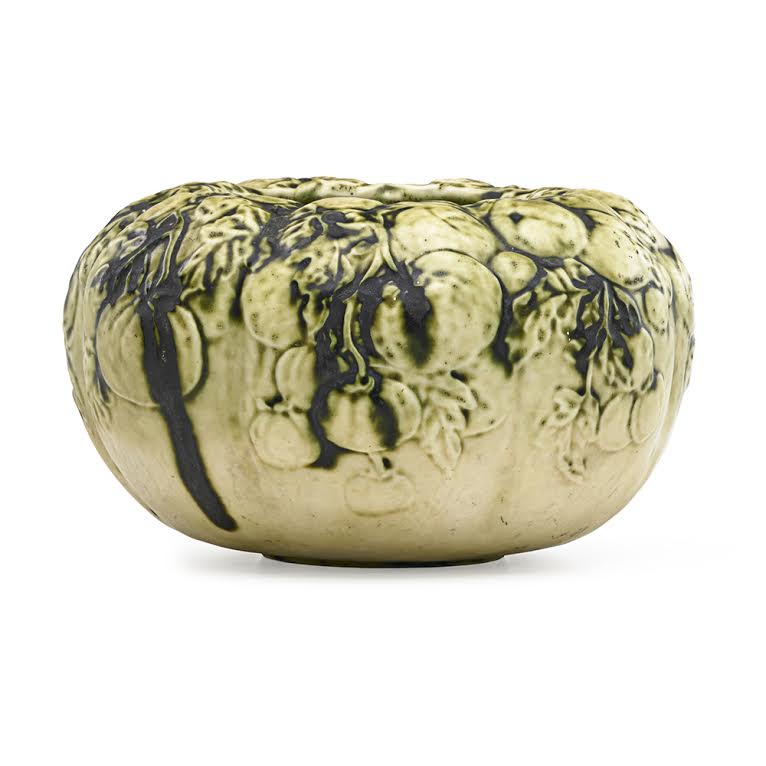
Tiffany Studios, Fine Favrile pottery bowl with tomatoes, green and ivory glaze, New York, ca. 1900. Sale Price: $13,750, Rago Arts & Auction Center
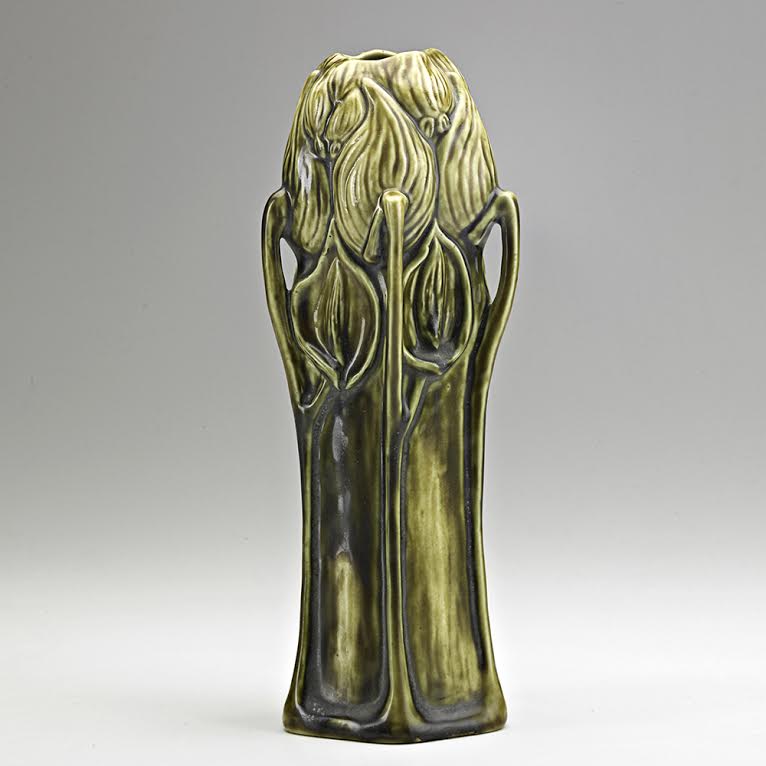
Tiffany Studios, Rare glazed earthenware milkweed vase, New York, 1900s. Sale Price: $42,500, Rago Arts & Auction Center
Let’s start by comparing vases and bowls. To simplify this exercise, assume you have a bowl and a vase made of the same material (pottery or glass, for example) by the same company, the same year, decorated by the same artist or one of similar value, in the same condition, and even the same size, though one is measured in height and the other in width. We’re pretty much talking about the same piece with that one notable exception. Would the value really be different?
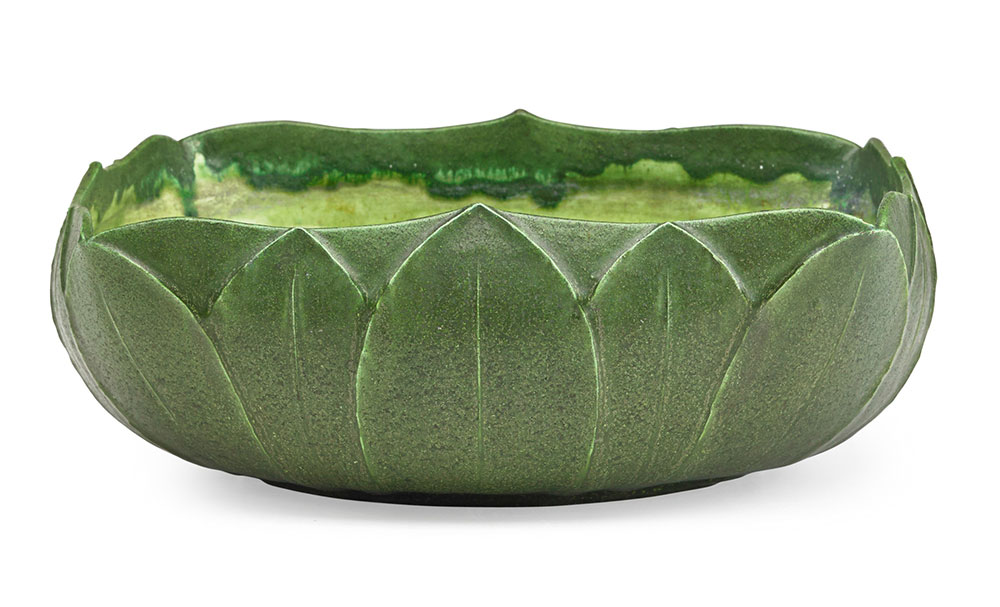
Grueby, Large low bowl carved with leaves, Boston, MA, ca. 1905. Sale Price: $1,625, Rago Arts & Auction Center
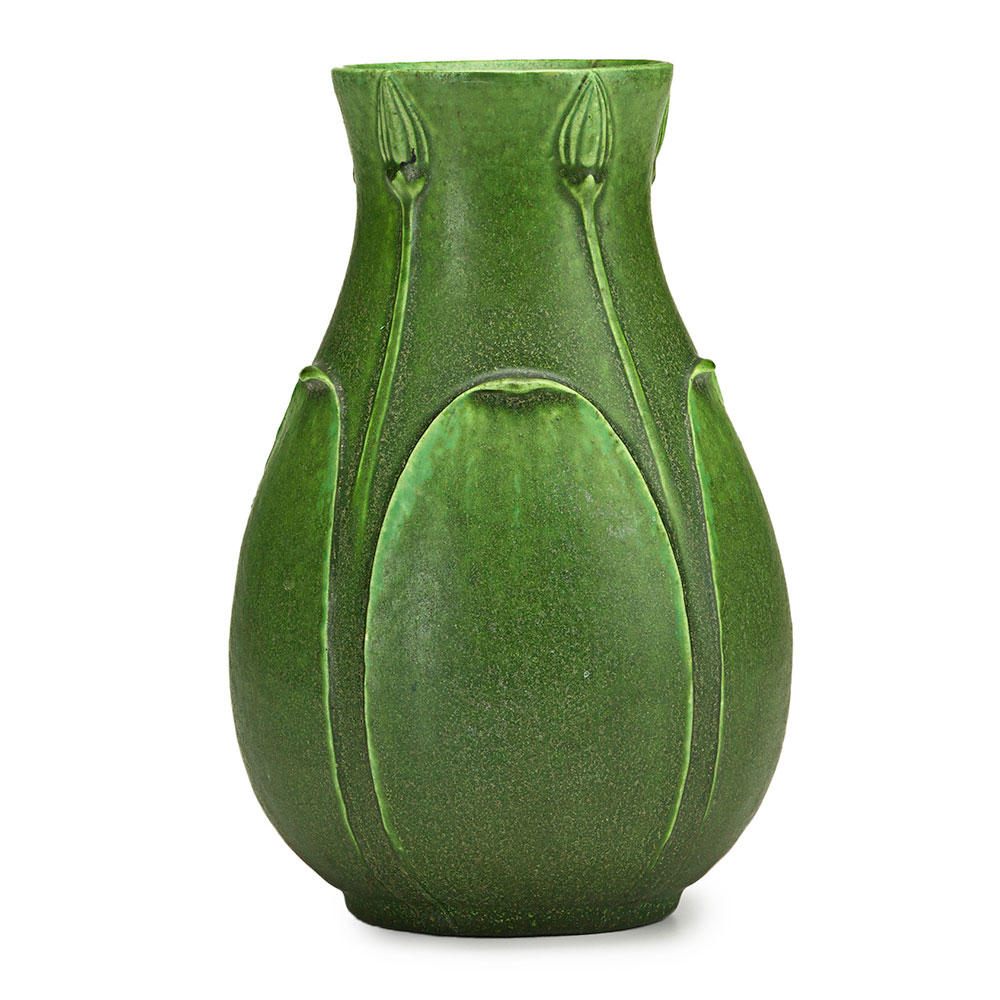
Grueby, Vase with buds and leaves, Boston, MA, ca. 1905. Sale Price: $2,125, Rago Arts & Auction Center
For starters, a bowl takes up nearly twice as much space on a collector’s shelf than a vase. Few people have unlimited yardage in their china cabinets or fireplace mantels, and many collectors eventually trade bowls for thinner works.
Second, and this is no small factor, a bowl doesn’t show off an artist’s work as well as a vase. If you don’t have a vase and a bowl sitting in front of you, envision how the vertical flow of the artistry is easier to read on a vase. Even if an artist “works with the form” when decorating a bowl, choosing a trailing vine or a lyrical floral design, the decoration has to wind around the bottom of the piece, at best rising just a few inches above the shelf.
Additionally, because most bowls flare as they rise, and since most light sources shine from above, the decoration on a bowl is usually not lit nearly as well as it would be on a vase form. A collector has to be very sensitive to lighting and placement to show off a bowl properly if for no other reason than this.
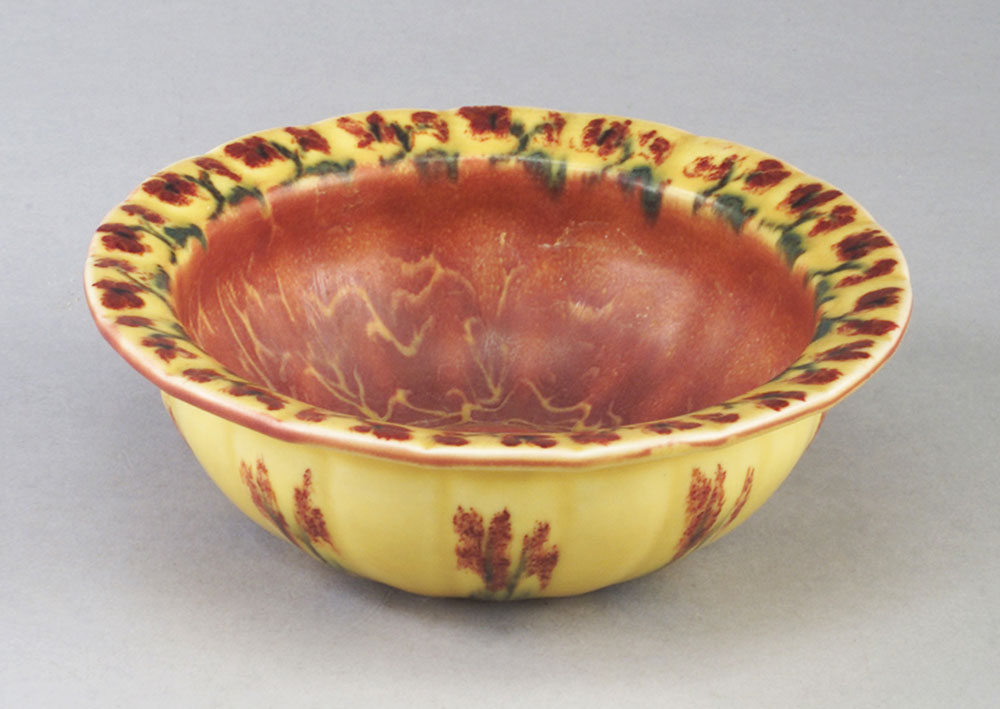
Unusual Rookwood Wax Matte bowl painted by Louise Abel with red blossoms on a mustard ground, the interior covered in a mottled burnt sienna glaze, 1924. Sale Price: $764, Rago Arts & Auction Center
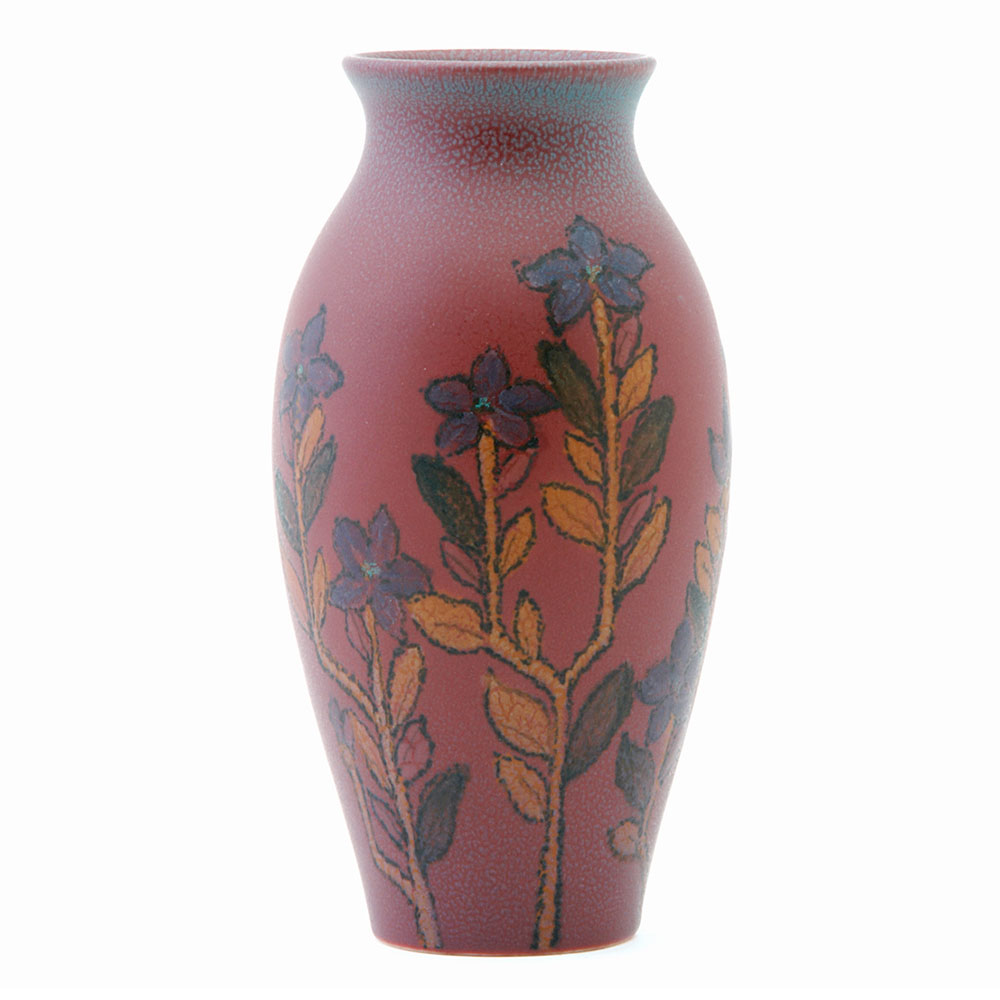
Rookwood Wax Matte vase painted by Mary Helen McDonald and/or Louise Abel with purple nicotina plants on a raspberry ground, 1922. Sale Price: $1,920, Rago Arts & Auction Center
Finally, bowls are more easily damaged than vases. A blow from above will often glance off of a straight sided vase. But the shape of a bowl, broad and flat, will often absorb the same level of impact, resulting in a chip or a crack. And bowls are more often employed in a way that can increase the likelihood of benign neglect. How many people have you seen force narcissus bulbs in a vase? Bowls are often available with flower frogs for this express purpose. The safest place for a valuable pot is in a cabinet or a high shelf, not the dining room table.
No shows until November, when we have four in a row. We’ll start in New Jersey at the Morristown Armory, then travel to Chicago for the Antiques + Modernism Winnetka show, followed by the Kansas City Antiques Expo, ending up back at the Pier in NYC for the usual November show. Remember to check my website for the latest items and keep reading my blog. We’ll spend a lot of time finding some great new items for our November circuit.
Click here to view our new website and look around. We always strive to offer the finest objects for sale on our website and at every show. There are many items for sale, sold items with prices and free lessons about glass and lamps.
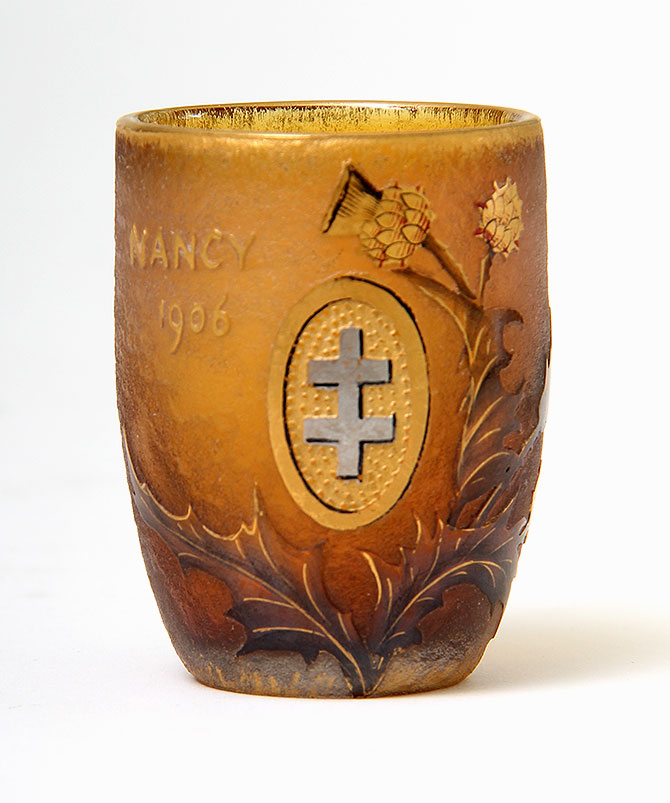

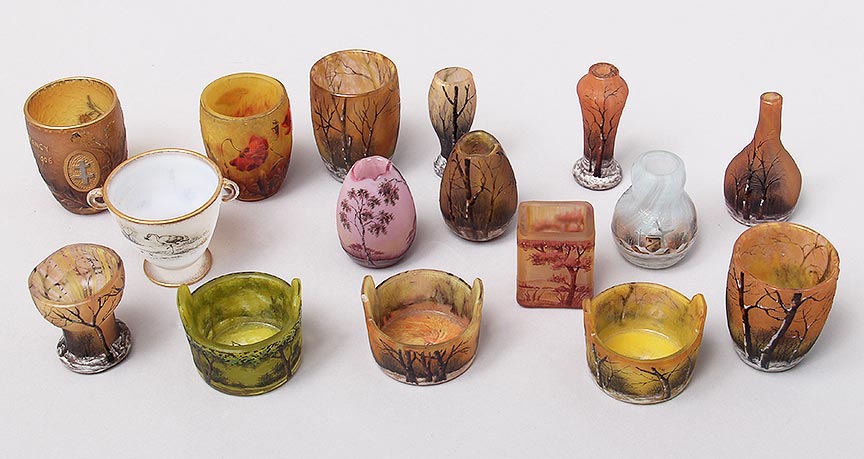
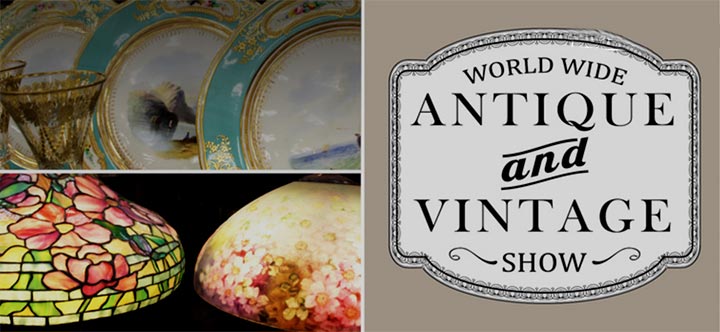

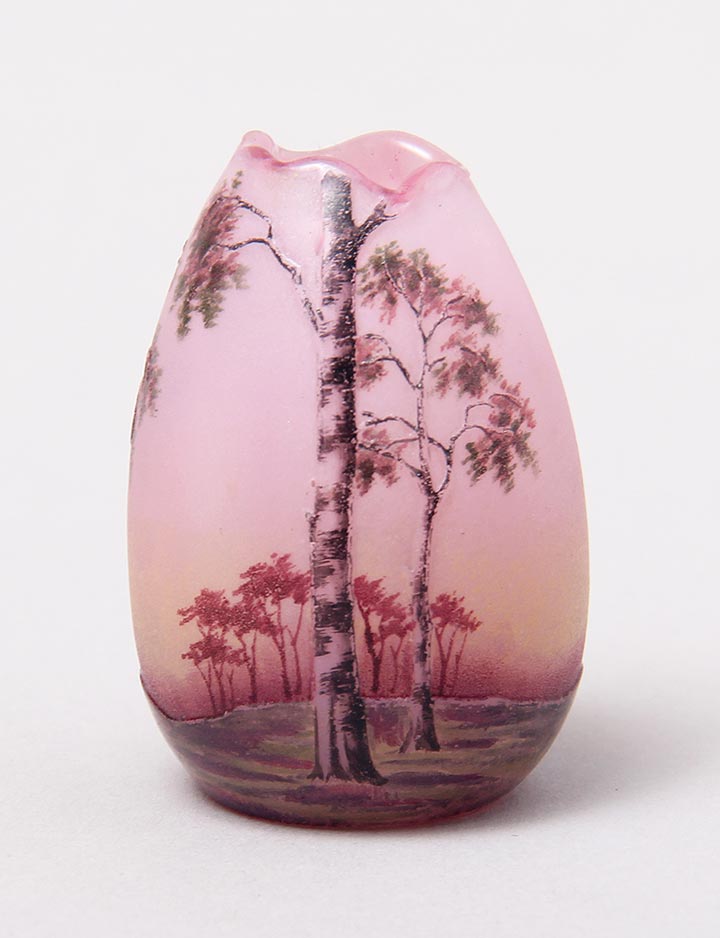
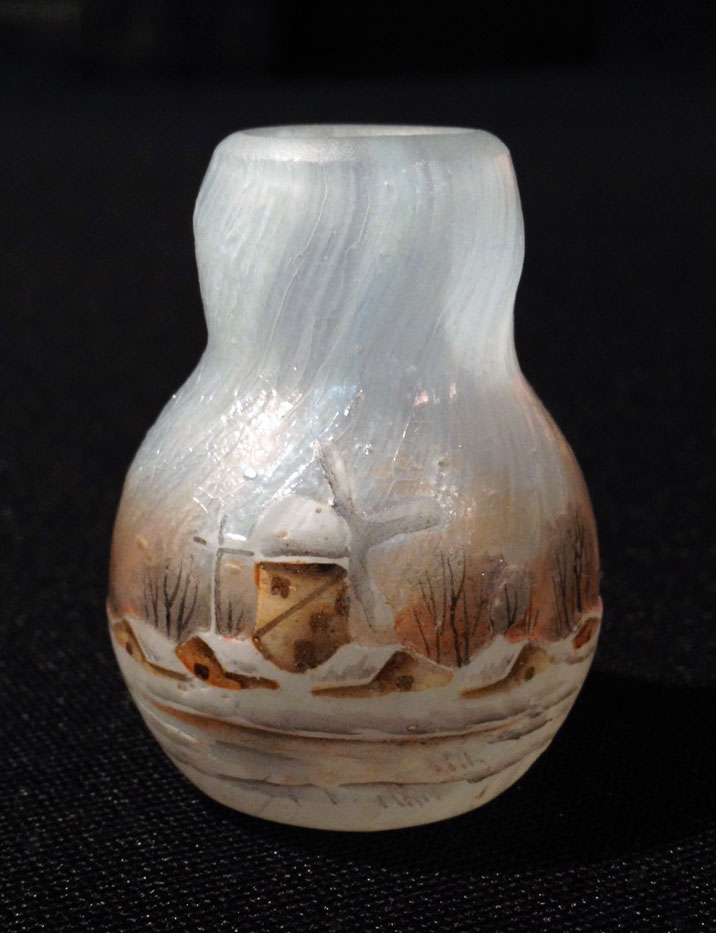
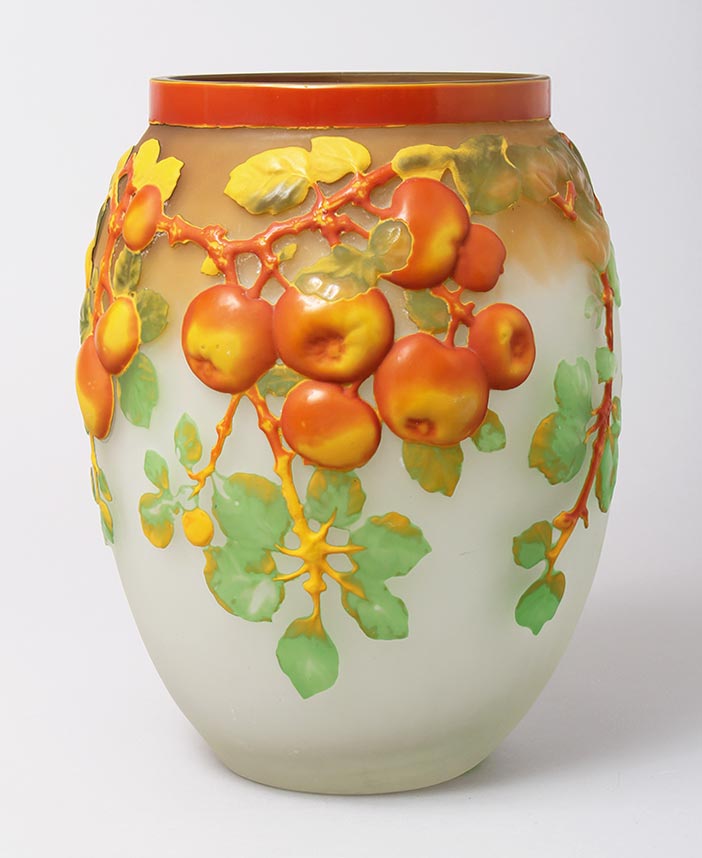
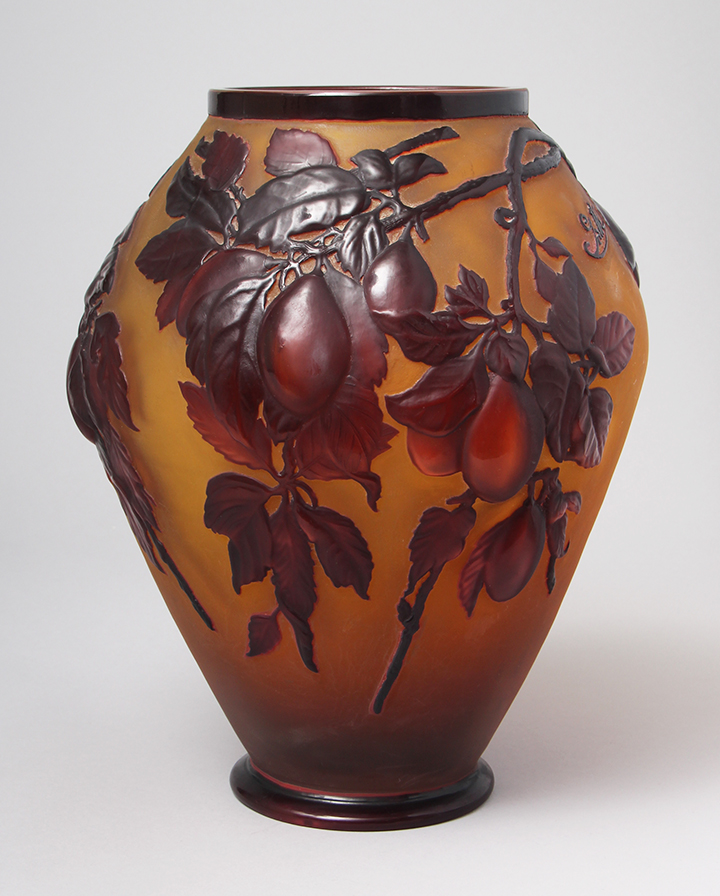
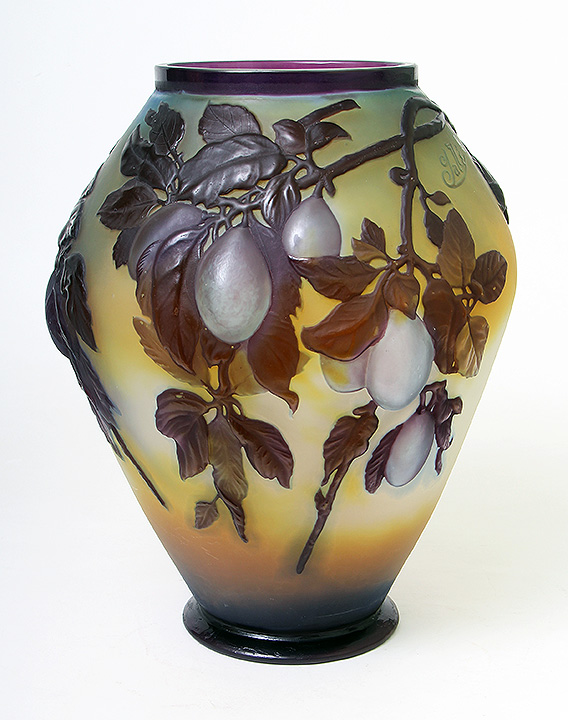
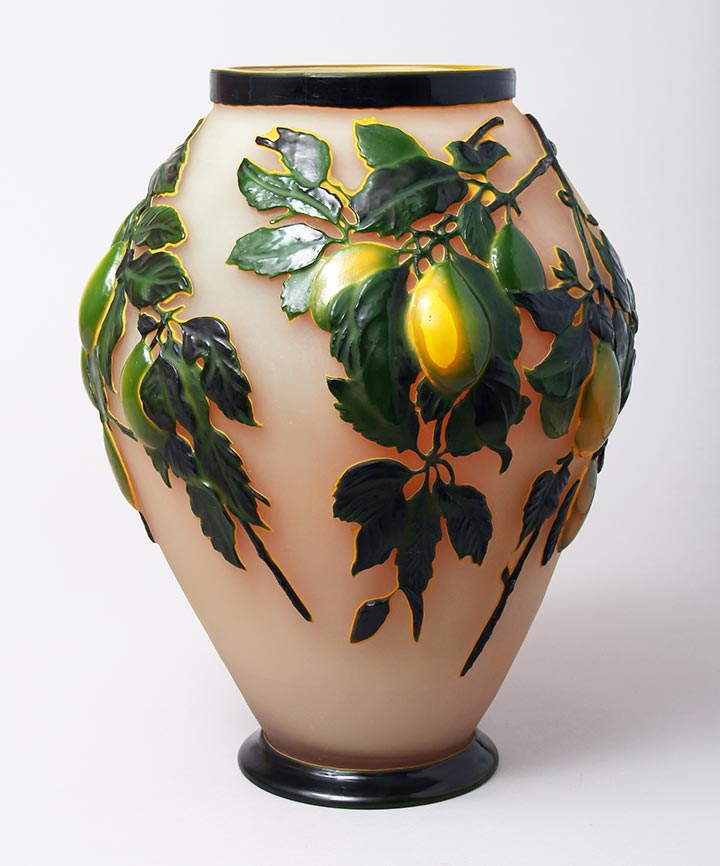
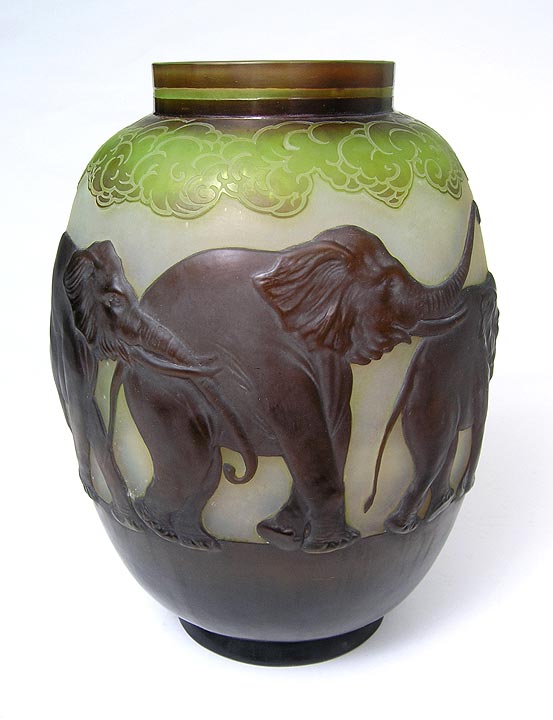
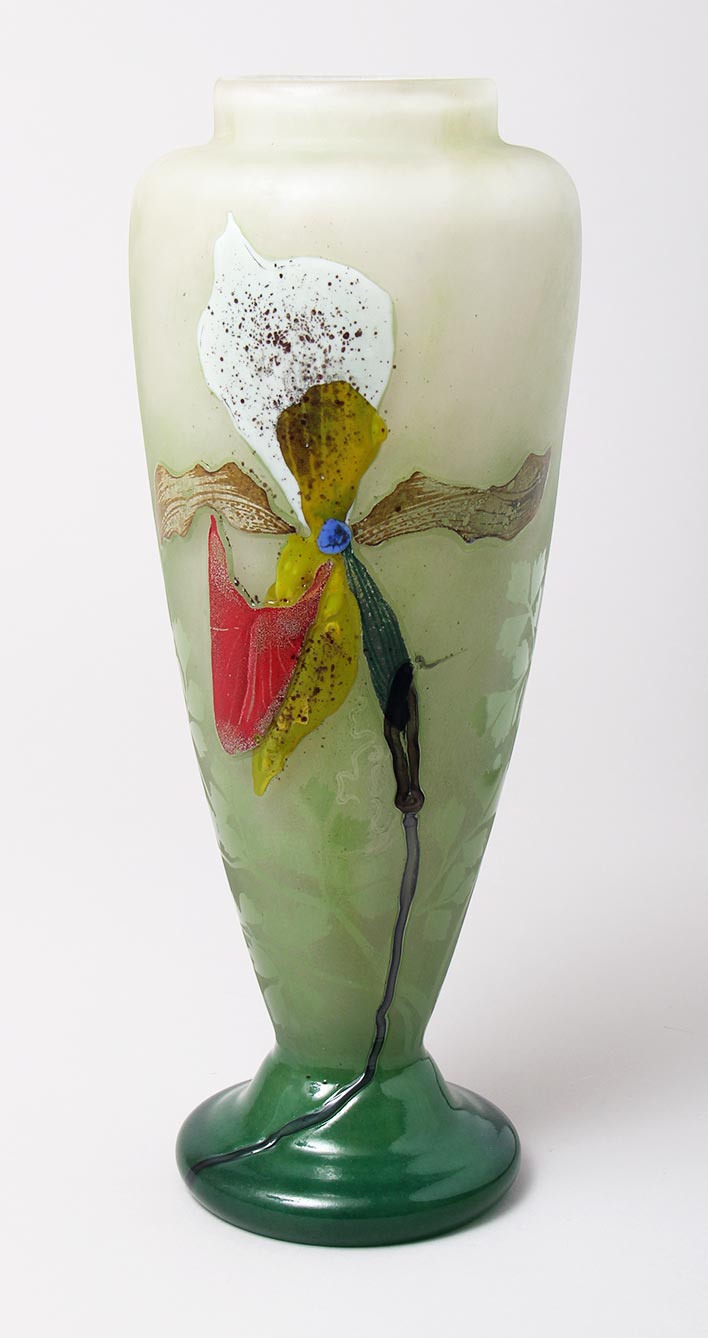
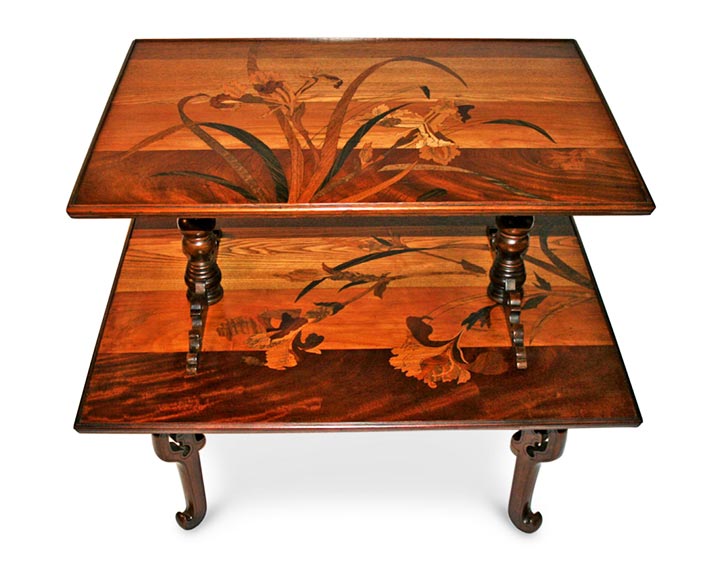
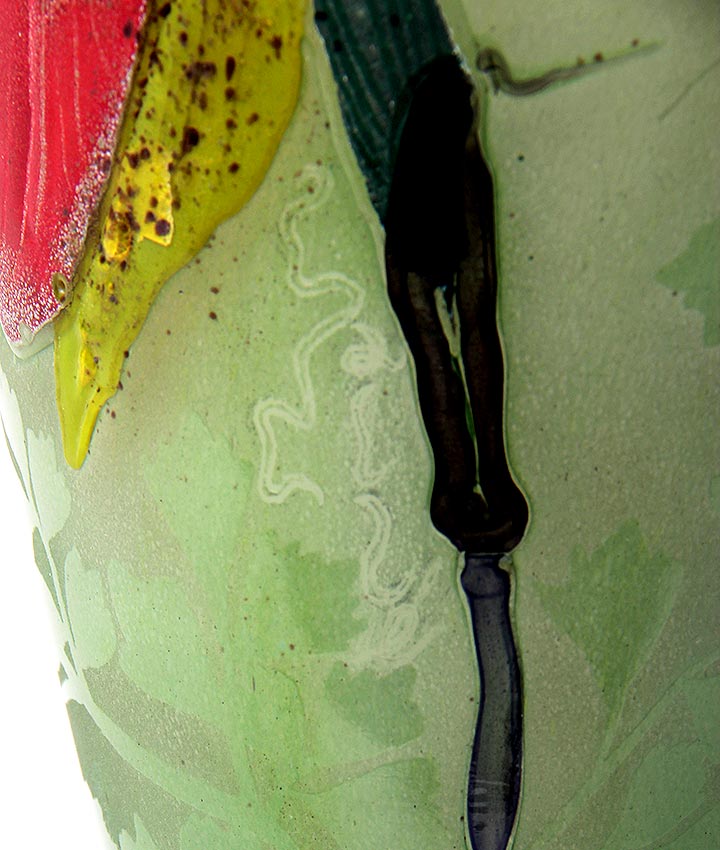
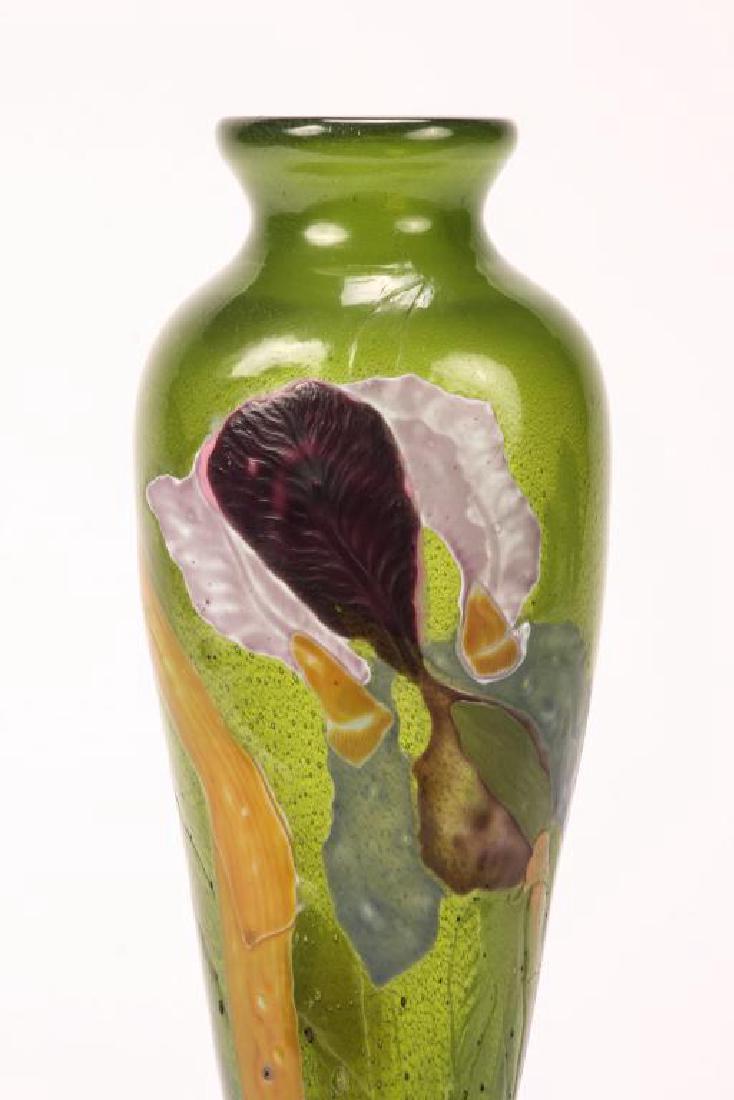
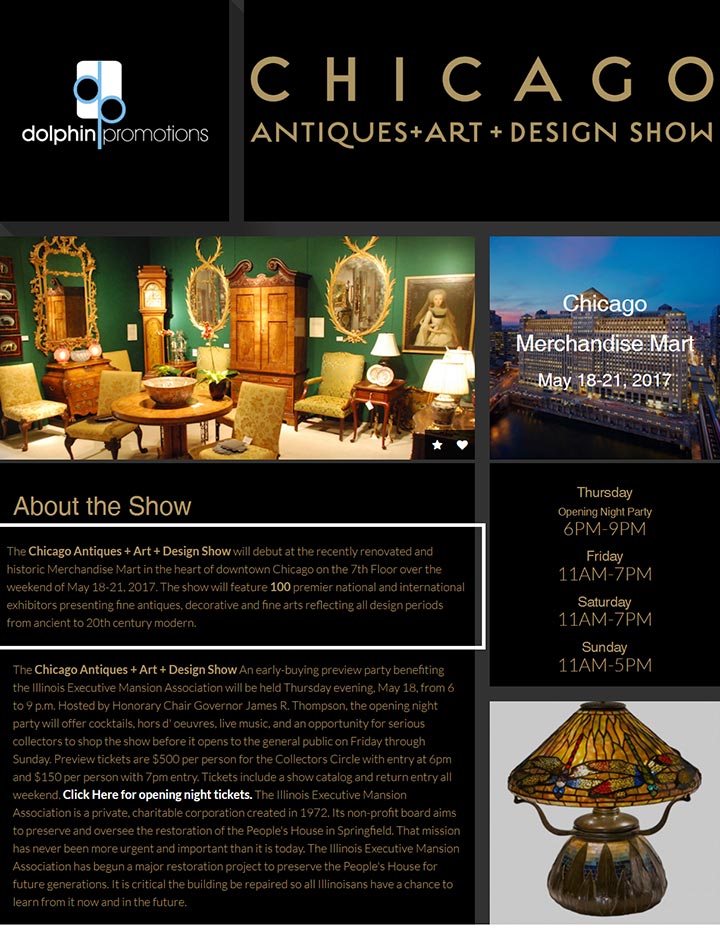 The revived Chicago Antiques + Art + Design Show at the Chicago Merchandise Mart opens to the public next Friday, May 19th. I was quite sad when the original show folded a few years ago, as it was always one of my favorite shows. The new edition will have a new promoter, Dolphin Promotions, headed by Rosemary Krieger. There hasn’t been an antique show in downtown Chicago for several years, so I’m hoping this one will be met with a lot of enthusiasm. The show runs from May 19-21, 2017, with a preview party the night of the 18th.
The revived Chicago Antiques + Art + Design Show at the Chicago Merchandise Mart opens to the public next Friday, May 19th. I was quite sad when the original show folded a few years ago, as it was always one of my favorite shows. The new edition will have a new promoter, Dolphin Promotions, headed by Rosemary Krieger. There hasn’t been an antique show in downtown Chicago for several years, so I’m hoping this one will be met with a lot of enthusiasm. The show runs from May 19-21, 2017, with a preview party the night of the 18th.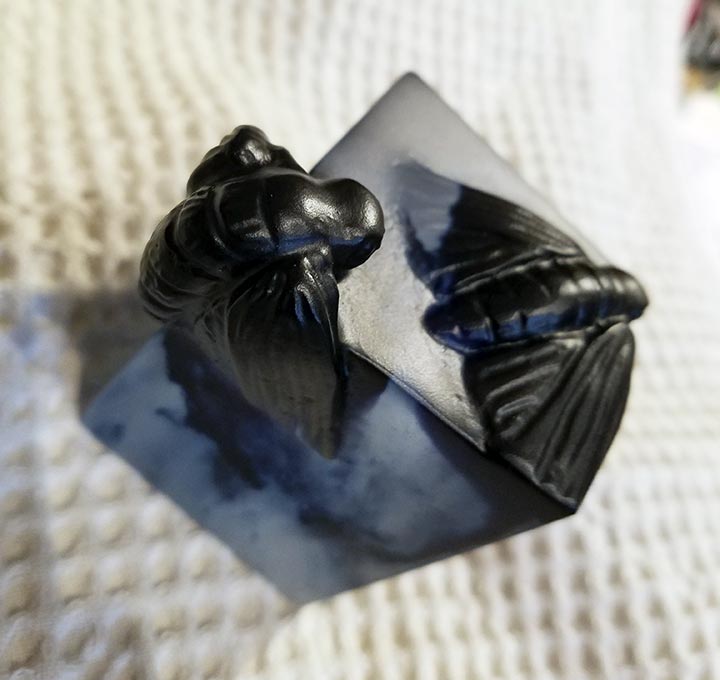
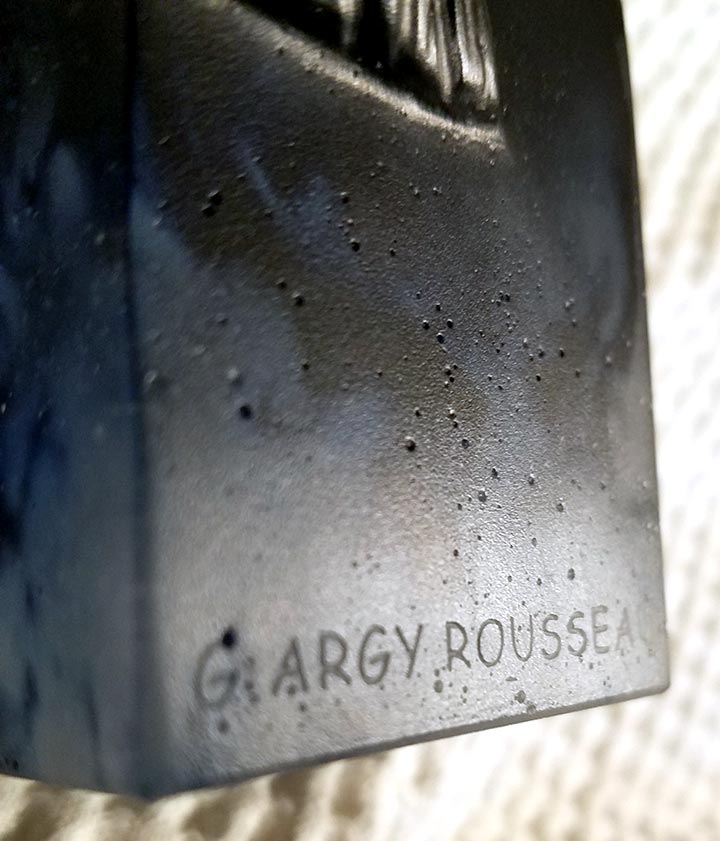
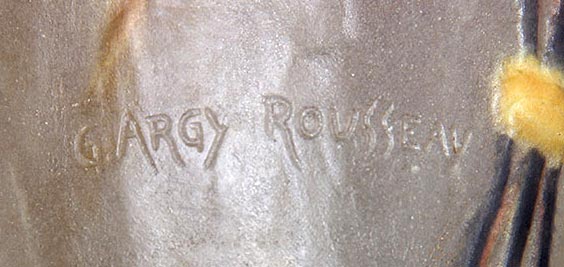

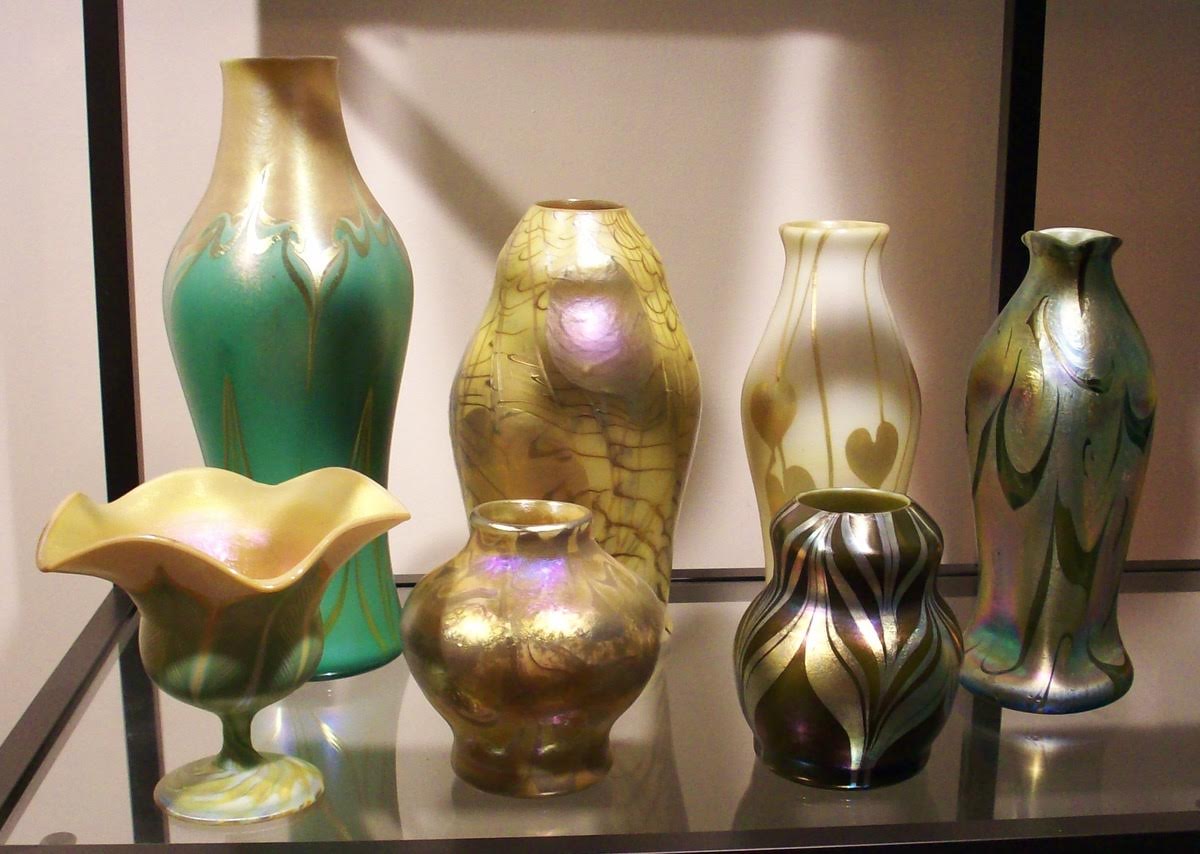
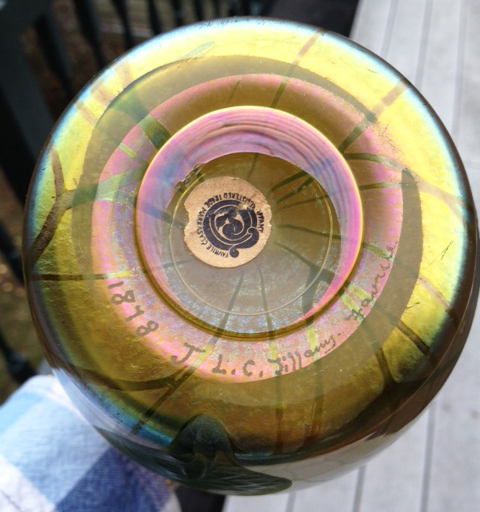
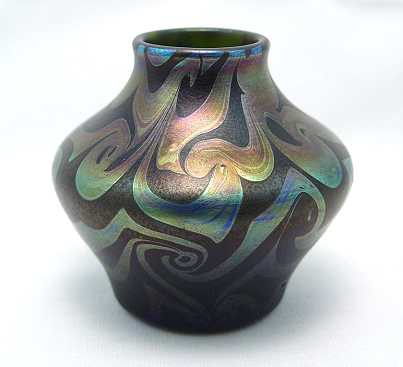
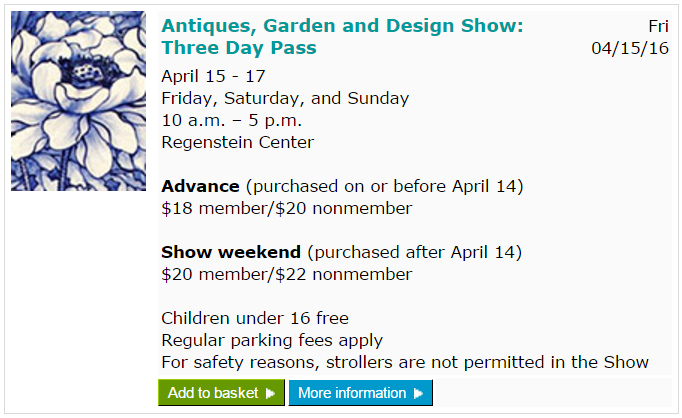
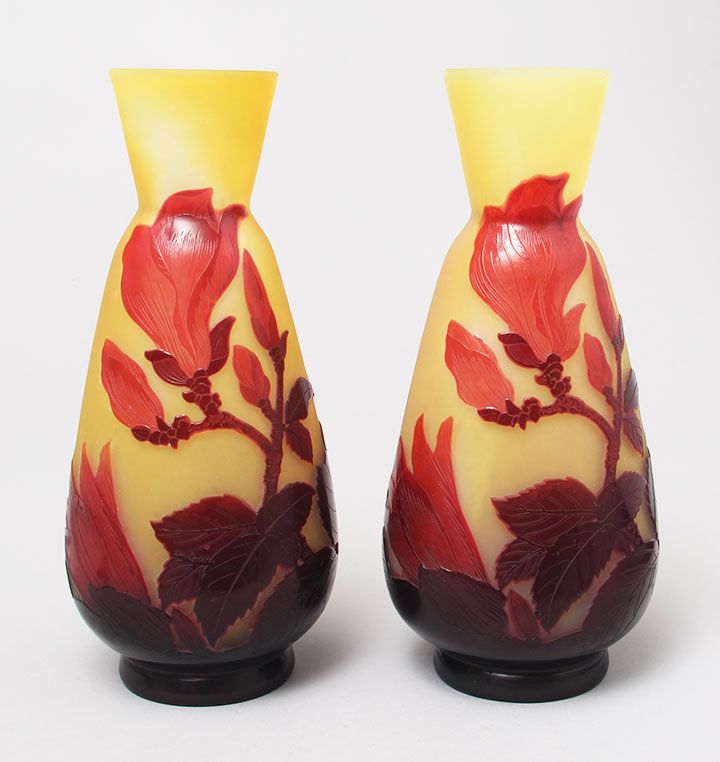
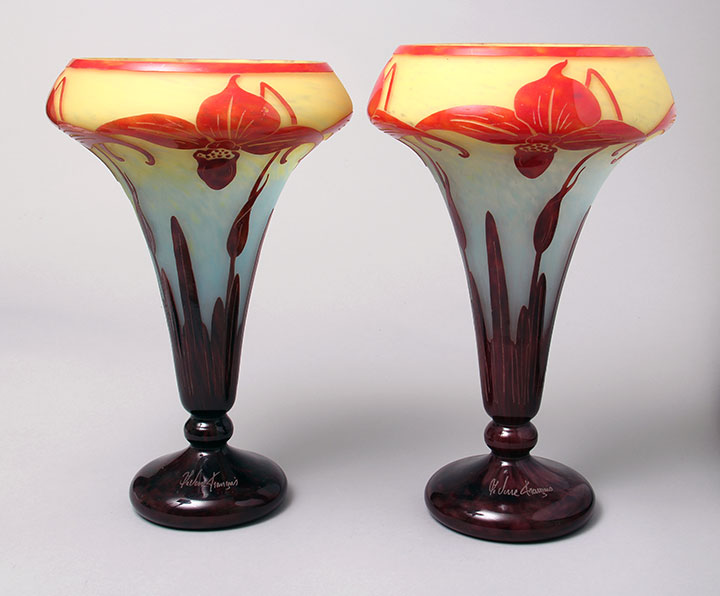
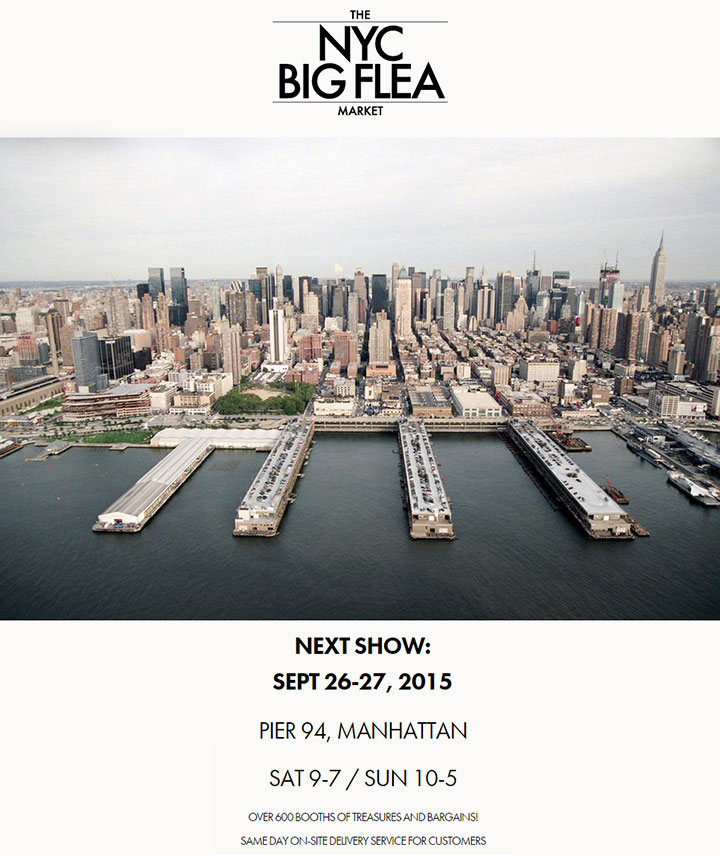 Our next show will be The Big Flea Market at Pier 94 in New York City, September 26-27. Last year was the first time for this show and it was good. The attendees were completely different than the established Pier Antique Show that takes place in November and March each year, making it a totally different experience.
Our next show will be The Big Flea Market at Pier 94 in New York City, September 26-27. Last year was the first time for this show and it was good. The attendees were completely different than the established Pier Antique Show that takes place in November and March each year, making it a totally different experience.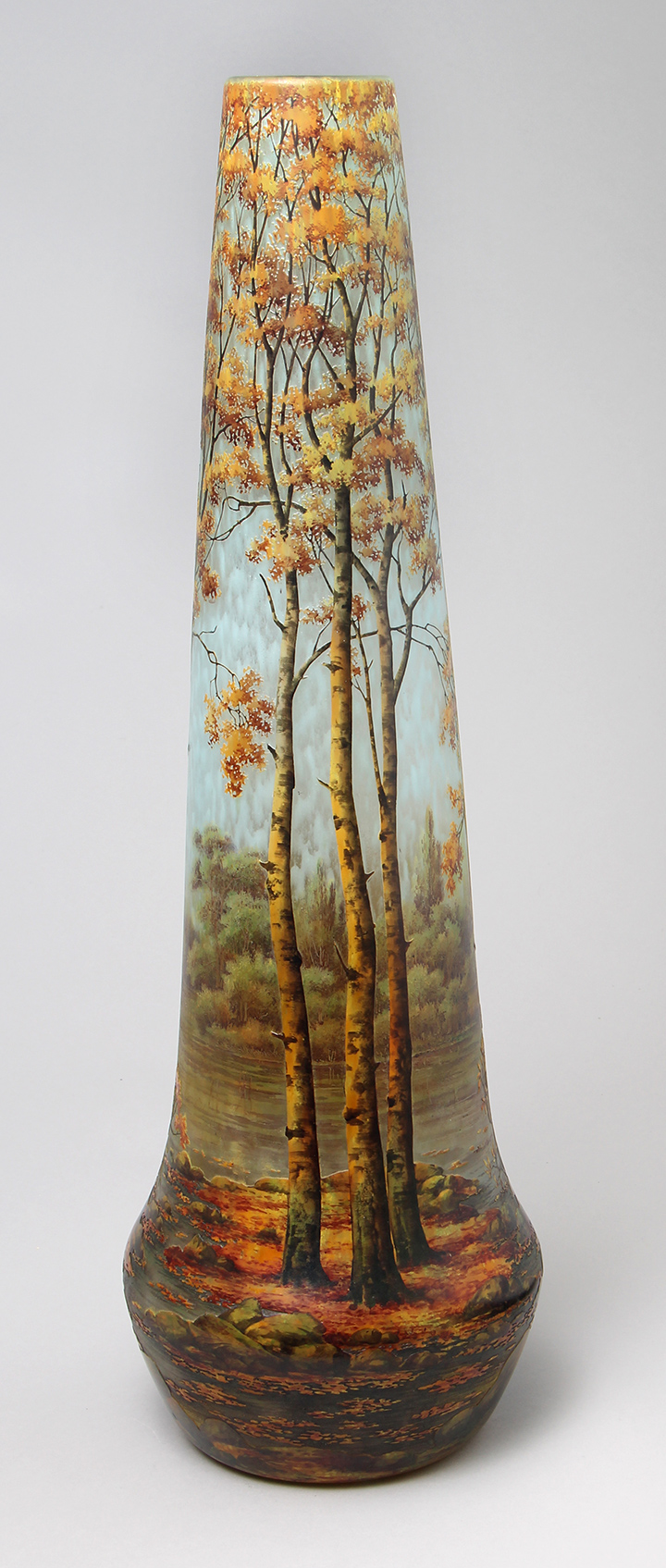
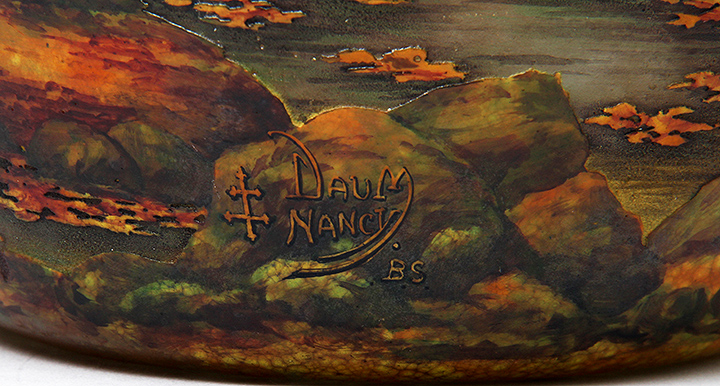
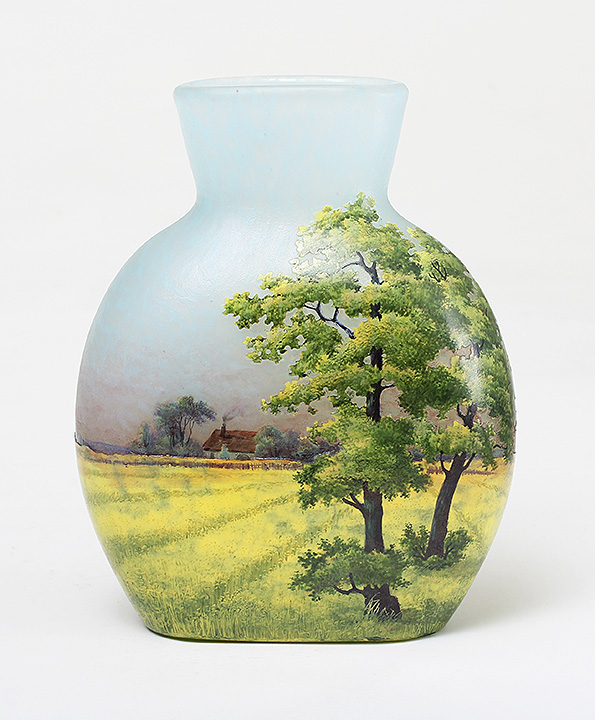
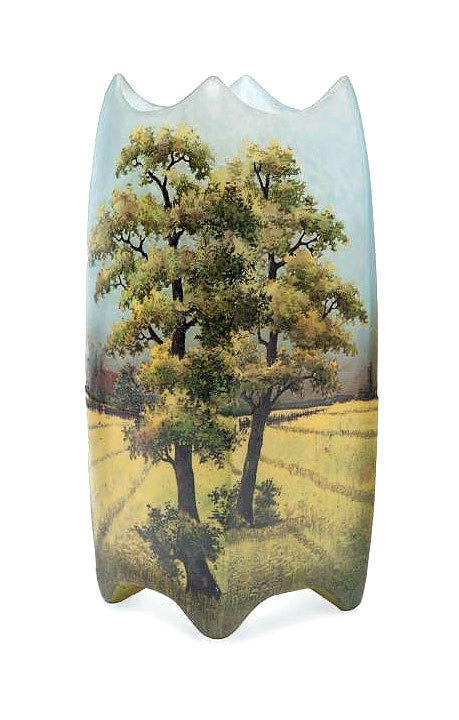
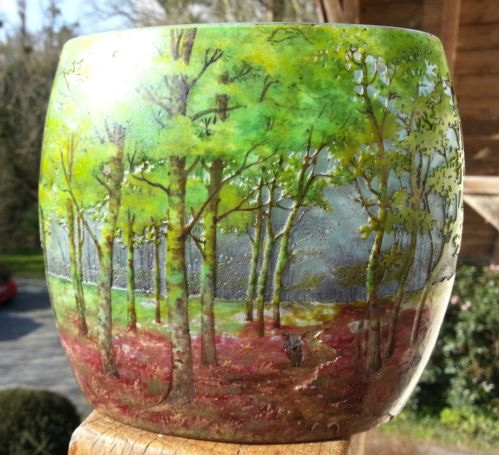
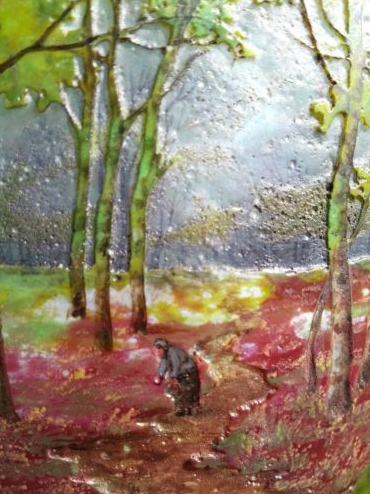 The shape is classical — a 5″ pillow vase. The decoration is not — bright spring colors and a woman picking flowers on a country path. Fabulous!! Technically there’s another detail that thrills me, but would bore most collectors. The trees go from being raised (by acid-etching) above the flower line to being recessed below it. I don’t have the vase in front of me, so I can’t tell if it was accomplished by acid-etching or wheel-carving. Sorry, but it’s a very cool detail that I’ve never seen before – that’s two extreme rarities in one vase.
The shape is classical — a 5″ pillow vase. The decoration is not — bright spring colors and a woman picking flowers on a country path. Fabulous!! Technically there’s another detail that thrills me, but would bore most collectors. The trees go from being raised (by acid-etching) above the flower line to being recessed below it. I don’t have the vase in front of me, so I can’t tell if it was accomplished by acid-etching or wheel-carving. Sorry, but it’s a very cool detail that I’ve never seen before – that’s two extreme rarities in one vase.